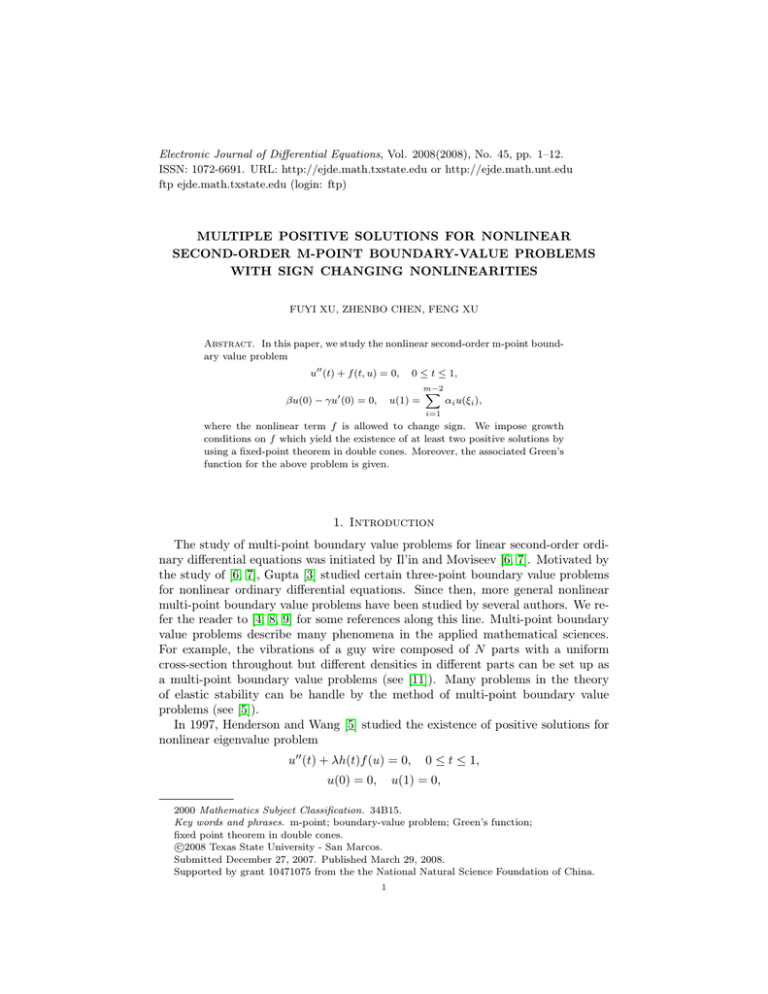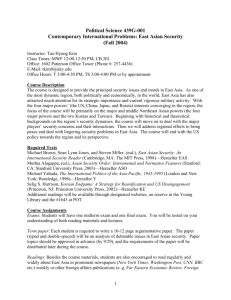Electronic Journal of Differential Equations, Vol. 2008(2008), No. 45, pp.... ISSN: 1072-6691. URL: or
advertisement

Electronic Journal of Differential Equations, Vol. 2008(2008), No. 45, pp. 1–12.
ISSN: 1072-6691. URL: http://ejde.math.txstate.edu or http://ejde.math.unt.edu
ftp ejde.math.txstate.edu (login: ftp)
MULTIPLE POSITIVE SOLUTIONS FOR NONLINEAR
SECOND-ORDER M-POINT BOUNDARY-VALUE PROBLEMS
WITH SIGN CHANGING NONLINEARITIES
FUYI XU, ZHENBO CHEN, FENG XU
Abstract. In this paper, we study the nonlinear second-order m-point boundary value problem
u00 (t) + f (t, u) = 0,
βu(0) − γu0 (0) = 0,
0 ≤ t ≤ 1,
u(1) =
m−2
X
αi u(ξi ),
i=1
where the nonlinear term f is allowed to change sign. We impose growth
conditions on f which yield the existence of at least two positive solutions by
using a fixed-point theorem in double cones. Moreover, the associated Green’s
function for the above problem is given.
1. Introduction
The study of multi-point boundary value problems for linear second-order ordinary differential equations was initiated by Il’in and Moviseev [6, 7]. Motivated by
the study of [6, 7], Gupta [3] studied certain three-point boundary value problems
for nonlinear ordinary differential equations. Since then, more general nonlinear
multi-point boundary value problems have been studied by several authors. We refer the reader to [4, 8, 9] for some references along this line. Multi-point boundary
value problems describe many phenomena in the applied mathematical sciences.
For example, the vibrations of a guy wire composed of N parts with a uniform
cross-section throughout but different densities in different parts can be set up as
a multi-point boundary value problems (see [11]). Many problems in the theory
of elastic stability can be handle by the method of multi-point boundary value
problems (see [5]).
In 1997, Henderson and Wang [5] studied the existence of positive solutions for
nonlinear eigenvalue problem
u00 (t) + λh(t)f (u) = 0,
u(0) = 0,
0 ≤ t ≤ 1,
u(1) = 0,
2000 Mathematics Subject Classification. 34B15.
Key words and phrases. m-point; boundary-value problem; Green’s function;
fixed point theorem in double cones.
c
2008
Texas State University - San Marcos.
Submitted December 27, 2007. Published March 29, 2008.
Supported by grant 10471075 from the the National Natural Science Foundation of China.
1
2
F. XU, Z. CHEN, F. XU
EJDE-2008/45
where f ∈ C([0, +∞), [0, +∞)) and h ∈ C([0, 1], [0, +∞)). The authors establish
the existence of positive solutions under the condition that f is either superlinear
or sublinear.
Ma [9] investigated the second-order three-point boundary value problem(BVP)
u00 (t) + a(t)f (u) = 0,
u(0) = 0,
0 ≤ t ≤ 1,
u(1) = αu(η),
where 0 < η < 1, 0 < αη < 1, f ∈ C([0, +∞), [0, +∞)), a ∈ C([0, 1], [0, +∞)). The
existence of at least one positive solution is obtained under the condition that f is
either superlinear or sublinear by applying Guo-Krasnoselskii’s fixed point theorem.
Recently, Ma [10] studied the second-order m-point boundary-value problem
u00 (t) + a(t)f (u) = 0,
u(0) = 0,
u(1) =
0 ≤ t ≤ 1,
m−2
X
αi u(ξi ),
i=1
where αi ≥ 0, i = 1, 2, . . . , m − 3, αm−2 > 0, 0 < ξ1 < ξ2 < · · · < ξm−2 < 1,
0 < Σm−2
i=1 αi ξi < 1, f ∈ C([0, +∞), [0, +∞)), a ∈ C([0, 1], [0, +∞)). The author
obtained the existence of at least one positive solution if f is either superlinear or
sublinear by applying a fixed-point theorem in cones.
All the above works were done under the assumption that the nonlinear term
is nonnegative, applying the concavity of solutions in the proofs. In this paper we
study the nonlinear second-order m-point boundary value problem
u00 (t) + f (t, u) = 0,
βu(0) − γu0 (0) = 0,
0 < t < 1,
u(1) =
m−2
X
αi u(ξi ),
(1.1)
(1.2)
i=1
where the nonlinear term f is allowed to change sign. Firstly we give the associated
Green’s function for the above problem which makes later discussions more precise.
Then certain growth conditions are imposed on f which yield the existence of at
least two positive solutions by using a new fixed-point theorem in double cones. In
this way we removed the usual restriction on f ≥ 0.
For a cone K in a Banach space X with norm k · k and a constant r > 0, let
Kr = {x ∈ K : kxk < r}, ∂Kr = {x ∈ K : kxk = r}. Suppose α : K → R+
is a continuously increasing functional; i.e., α is continuous and α(λx) ≤ α(x) for
λ ∈ (0, 1). Let
K(b) = {x ∈ K : α(x) < b}, ∂K(b) = {x ∈ K : α(x) = b}.
and Ka (b) = {x ∈ K : a < kxk, α(x) < b}. The origin in X is denoted by θ.
Our main tool of this paper is the following fixed point theorem in double cones.
Theorem 1.1 ([1]). Let X be a real Banach space with norm k · k and K, K 0 ⊂ X
two solid cones with K 0 ⊂ K. Suppose T : K → K and T 0 : K 0 → K 0 are two
completely continuous operators and α : K 0 → R+ is a continuously increasing
functional satisfying α(x) ≤ kxk ≤ M α(x) for all x ∈ K 0 , where M ≥ 1 is a
constant. If there are constants b > a > 0 such that
(C1) kT xk < a, for x ∈ ∂Ka ;
(C2) kT 0 xk < a, for x ∈ ∂Ka0 and α(T 0 x) > b for x ∈ ∂K 0 (b);
(C3) T x = T 0 x, for x ∈ Ka0 (b) ∩ {u : T 0 u = u}.
EJDE-2008/45
MULTIPLE POSITIVE SOLUTIONS
3
Then T has at least two fixed points y1 and y2 in K, such that
0 ≤ ky1 k < a < ky2 k,
α(y2 ) < b.
2. Preliminaries
In this section, we present some lemmas that are important to prove our main
results.
Pm−2
Pm−2
Lemma 2.1. Suppose that d = β(1 − i=1 ai ξi ) + γ(1 − i=1 ai ) 6= 0 and y(t) ∈
C[0, 1]. Then boundary-value problem
u00 (t) + y(t) = 0,
βu(0) − γu0 (0) = 0,
0 < t < 1,
u(1) =
m−2
X
ai u(ξi ).
(2.1)
(2.2)
i=1
has a unique solution
t
Z
u(t) = −
(t − s)y(s)ds +
0
βt + γ
d
1
Z
(1 − s)y(s)ds
0
Z ξi
m−2
βt + γ X
ai
(ξi − s)y(s)ds
−
d
0
i=1
Proof. Integrating both sides of (2.1) on [0, t], we have
Z t
y(s)ds + u0 (0).
u0 (t) = −
(2.3)
(2.4)
0
Again integrating (2.4) from 0 to t, we get
Z t
u(t) = −
(t − s)y(s)ds + u0 (0)t + u(0).
(2.5)
0
In particular,
Z
1
u(1) = −
Z
u(ξi ) = −
0
ξi
(1 − s)y(s)ds + u0 (0) + u(0),
(ξi − s)y(s)ds + u0 (0)ξi + u(0).
0
By (2.2) we get
u0 (0) =
βh
d
Z
1
(1 − s)y(s)ds −
0
The proof is complete.
m−2
X
i=1
Z
ai
ξi
i
(ξi − s)y(s)ds .
0
Pm−2
Lemma 2.2. Let 0 < i=1 ai ξi < 1, d > 0. If y ∈ C[0, 1] and y ≥ 0, then the
unique solution u of (2.1)-(2.2) satisfies u(t) ≥ 0.
Proof. Since u00 (t) = −y(t) ≤ 0, we know that the graph of u(t) is concave down
on (0, 1). So we only prove u(0) ≥ 0, u(1) ≥ 0.
Firstly, we shall prove u(0) ≥ 0 in the following two cases
4
F. XU, Z. CHEN, F. XU
EJDE-2008/45
Pm−2
ai ≤ 1, by (2.3) we have
Z
m−2
X Z ξi
γh 1
u(0) =
(1 − s)y(s)ds −
ai
(ξi − s)y(s)ds
d 0
0
i=1
Z
Z
m−2
1
i
X
γh 1
(1 − s)y(s)ds −
≥
ai
(1 − s)y(s)ds
d 0
0
i=1
Z
m−2
X 1
γ
1−
=
ai
(1 − s)y(s)ds ≥ 0.
d
0
i=1
Pm−2
Case ii: If i=1 ai > 1, by (2.3) we have
Z
m−2
i
X Z ξi
γh 1
(ξi − s)y(s)ds
(1 − s)y(s)ds −
ai
u(0) =
d 0
0
i=1
Z 1
Z
m−2
1
h
i
X
γ
ai
≥
(1 − s)y(s)ds −
(ξi − s)y(s)ds
d 0
0
i=1
Z
m−2
m−2
i
X
X
γ 1h
=
(1 −
ai ξi ) + (
ai − 1)s y(s)ds ≥ 0.
d 0
i=1
i=1
Case i: If 0 <
i=1
On the other hand, by (2.3) we have
Z 1
Z
β+γ 1
u(1) = −
(1 − s)y(s)ds +
(1 − s)y(s)ds
d
0
0
Z ξi
m−2
β+γ X
−
ai
(ξi − s)y(s)ds
d i=1
0
Z ξi
Z 1
m−2
m−2
i
X
βh X
ai
(ξi (1 − s) − (ξi − s))y(s)ds +
ai ξi
(1 − s)y(s)ds
≥
d i=1
0
ξi
i=1
Z
Z
m−2
1
1
h
i
γ X
+
ai
(1 − s)y(s)ds −
(ξi − s)y(s)ds
d i=1
0
0
Z
Z 1
m−2
i
β X h ξi
ai
(1 − ξi )sy(s)ds + ξi
(1 − s)y(s)ds
=
d i=1
0
ξi
Z
m−2
i
γ X h 1
+
ai
(1 − ξi )y(s)ds ≥ 0.
d i=1
0
The proof is complete.
Pm−2
Lemma 2.3. Let i=1 ai ξi > 1, d 6= 0. If y ∈ C[0, 1] and y ≥ 0, then (2.1)-(2.2)
has no positive solution.
Proof. On the contrary, suppose that (2.1)-(2.2) has a positive solution u, then
u(ξi ) > 0, i = 1, 2, . . . , m − 2 and
u(1) =
m−2
X
i=1
ai u(ξi ) =
m−2
X
i=1
ai ξi
m−2
X
u(ξi )
u(ξ)
u(ξ)
≥
ai ξi
>
,
ξi
ξ
ξ
i=1
EJDE-2008/45
MULTIPLE POSITIVE SOLUTIONS
5
where ξ = min{ξ1 , ξ2 , . . . , ξm−2 } satisfies
u(ξ1 ) u(ξ2 )
u(ξ)
u(ξm−2 ) = min
,
,
,...,
ξ1
ξ2
ξm−2
ξ
which contradicts to the concave of u(t). The proof is complete.
Pm−2
Lemma 2.4. Let ai ≥ 0, i = 1, . . . , m−2, 0 < i=1 ai ξi < 1, d > 0. If y ∈ C[0, 1]
and y ≥ 0, then the unique positive solution u(t) of (2.1)-(2.2) satisfies
u(t) ≥ σkuk,
inf
t∈[ξm−2 ,1]
where
σ = min
am−2 (1 − ξm−2 )
, am−2 ξm−2 , ξm−2 ,
1 − am−2 ξm−2
kuk = sup |u(t)|.
t∈[0,1]
Proof. Let u(t) = maxt∈[0,1] u(t) = kuk, we shall discuss it from the following two
cases:
Pm−2
Case 1: If 0 <
assume that t < ξm−2 < 1, so that
i=1 ai < 1. Firstly,
Pm−2
mint∈[ξm−2 ,1] u(t) = u(1). By u(1) = i=1 ai u(ξi ) ≥ am−2 u(ξm−2 ) we have
u(1) − u(ξm−2 )
(0 − 1)
1 − ξm−2
1
1
= u(1) −
u(1) +
u(ξm−2 )
1 − ξm−2
1 − ξm−2
1
1
≤ u(1) 1 −
+
1 − ξm−2
am−2 (1 − ξm−2 )
1 − am−2 ξm−2
= u(1)
.
am−2 (1 − ξm−2 )
u(t) ≤ u(1) +
So that
am−2 (1 − ξm−2 )
kuk.
(2.6)
1 − am−2 ξm−2
t∈[ξm−2 ,1]
Secondly, assume ξm−2 < t < 1, then mint∈[ξm−2 ,1] u(t) = u(1). Otherwise, we
have mint∈[ξm−2 ,1] u(t) = u(ξm−2 ), then t ∈ [ξm−2 , 1], u(ξm−2 ) ≥ u(ξm−1 ) ≥ · · · ≥
Pm−2
u(ξ2 ) ≥ u(ξ1 ). By 0 < i=1 ai < 1 we have
min
u(1) =
m−2
X
u(t) ≥
ai u(ξi ) ≤
i=1
m−2
X
ai u(ξm−2 ) < u(ξm−2 ) ≤ u(1)
i=1
which is a contradiction. Since u(t) is concave,
u(ξm−2 )
u(t)
≥
≥ u(t).
ξm−2
t
In fact, since u(1) ≥ am−2 u(ξm−2 ), then
min
t∈[ξm−2 ,1]
u(1)
am−2 ξm−2
≥ u(t), which implies
u(t) ≥ am−2 ξm−2 kuk.
(2.7)
Pm−2
Case 2: If i=1 ai > 1. Firstly, assume u(ξm−2 ) ≤ u(1), then mint∈[ξm−2 ,1] u(t) =
u(ξm−2 ). By concave of u(t) we have t ∈ [ξm−2 , 1], which implies
u(ξm−2 )
u(t)
≥
≥ u(t),
ξm−2
t
6
F. XU, Z. CHEN, F. XU
EJDE-2008/45
then
min
t∈[ξm−2 ,1]
u(t) ≥ ξm−2 kuk.
(2.8)
Secondly, assume u(ξm−2 ) > u(1), and so mint∈[ξm−2 ,1] u(t) = u(1), and t ∈ [ξ1 , 1].
If not, t ∈ [0, ξ1 ), then u(ξ1 ) ≥ · · · ≥ u(ξm−2 ) > u(1). So we have
u(1) =
m−2
X
ai u(ξi ) > u(1)
i=1
m−2
X
ai ≥ u(1)
i=1
Pm−2
which is a contradiction. Since i=1 ai > 1, there exists ξ ∈ {ξ1 , ξ2 , . . . , ξm−2 }
such that u(ξ) ≤ u(1), then u(ξ1 ) ≤ u(ξ2 ) ≤ · · · ≤ u(ξm−2 ) ≤ u(1). Since u(t) is
u(ξ1 )
u(t)
concave, we have u(1)
ξ1 ≥ ξ1 ≥ t ≥ u(t), then
min
t∈[ξm−2 ,1]
u(t) ≥ ξ1 kuk.
(2.9)
Therefore, by (2.6)-(2.9) we have inf t∈[ξm−2 ,1] u(t) ≥ σkuk, where
σ = min
am−2 (1 − ξm−2 )
, am−2 ξm−2 , ξm−2 .
1 − am−2 ξm−2
The proof is complete.
Lemma 2.5. Suppose that d 6= 0. Then the boundary value problem
−u00 (t) = 0,
βu(0) − γu0 (0) = 0,
0 < t < 1,
u(1) =
m−2
X
ai u(ξi )
i=1
has Green’s function
P
(βs+γ) (1−t)− m−2
j=1 aj (ξj −t)
,
d
if
0
≤
t
≤
1,
s
≤
ξ
,
s
≤
t;
1
Pi−1
P
(βs+γ)(1−t)− m−2
j=1 aj (βξj +γ)(t−s)
j=i aj (ξj −t)(βs+γ)+
,
d
if ξ
r−1 ≤ t ≤ ξr , 2 ≤ r ≤ m − 1, ξi−1 ≤ s ≤ ξi , 2 ≤ i ≤ r, s ≤ t;
G(t, s) =
Pm−2
(βt+γ) (1−s)− j=i aj (ξj −s) ,
d
if
ξ
≤
t
≤
ξr , 2 ≤ r ≤ m − 1, ξi−1 ≤ s ≤ ξi , 2 ≤ i ≤ r, t ≤ s;
r−1
(βt+γ)(1−s)
,
d
if 0 ≤ t ≤ 1, ξ
m−2 ≤ s ≤ 1, t ≤ s.
(2.10)
Here for the sake of convenience, we write ξ0 = 0, ξm−1 = 1.
Proof. If 0 ≤ t ≤ ξ1 , the unique solution (2.3) given by Lemma 2.1 can be rewritten
as
Pm−2
Z t
(βs + γ) (1 − t) − j=1 aj (ξj − t)
u(t) =
y(s)ds
d
0
Pm−2
Z ξ1
(βt + γ) (1 − s) − j=1 aj (ξj − s)
y(s)ds
+
d
t
EJDE-2008/45
MULTIPLE POSITIVE SOLUTIONS
+
m−2
X Z ξi
Pm−2
(βt + γ) (1 − s) − j=i aj (ξj − s)
d
ξi−1
i=2
Z 1
7
y(s)ds
(βt + γ)(1 − s)
y(s)ds.
d
+
ξm−2
Similarly, if ξr−1 ≤ t ≤ ξr , 2 ≤ r ≤ m−2, the unique solution (2.3) can be expressed
Pm−2
Z ξ1
(βs + γ) (1 − t) − j=1 aj (ξj − t)
y(s)ds
u(t) =
d
0
r−1 Z ξi h
m−2
X
X
+
(βs + γ)(1 − t) −
aj (ξj − t)(βs + γ)
i=2
ξi−1
j=i
i−1
X
i y(s)
ds
+
aj (β1 ξj + γ)(t − s)
d
j=1
Z
t
h
+
(βs + γ)(1 − t) −
ξr−1
+
+
+
m−2
X
aj (ξj − t)(βs + γ)
j=r
i−1
X
i y(s)
ds
aj (βξj + γ)(t − s)
d
j=1
Pm−2
Z ξr
(βt + γ) (1 − s) − j=r aj (ξj − s)
y(s)ds
Pm−2
(βt + γ) (1 − s) − j=i aj (ξj − s)
d
t
m−2
X
Z
ξi
ξi−1
i=r+1
Z 1
+
ξm−2
d
y(s)ds
(βt + γ)(1 − s)
y(s)ds.
d
If ξm−2 ≤ t ≤ 1, the unique solution (2.3) can be given in the form
Pm−2
Z ξ1
(βs + γ) (1 − t) − j=1 aj (ξj − t)
u(t) =
y(s)ds
d
0
m−2
m−2
X Z ξi h
X
+
(βs + γ)(1 − t) −
aj (ξj − t)(βs + γ)
i=2
ξi−1
j=i
i−1
X
i y(s)
+
aj (βξj + γ)(t − s)
ds
d1
j=1
Pi−1
Z t
(βs + γ)(1 − t) + j=1 aj (βξj + γ)(t − s)
+
y(s)ds
d
ξm−2
Z 1
(βt + γ)(1 − s)
+
y(s)ds.
d
t
The lemma is proved.
Now let X = C[0, 1], K = {u ∈ X : u(t) ≥ 0, ∀t ∈ [0, 1]}, K 0 = {u ∈ X :
u is nonnegative, concave, and nonincreasing}. Equip X with the supremum norm
8
F. XU, Z. CHEN, F. XU
EJDE-2008/45
kuk := supt∈[0,1] |u(t)|. Clearly, K, K 0 ⊂ X are cones with K 0 ⊂ K. For ∀u ∈ K,
define
α(u) =
(T u)(t) =
1
Z
min
ξm−2 ≤t≤1
u(t),
+
G(t, s)f (s, u(s))ds ,
t ∈ [0, 1],
0
where (B)+ = max{B, 0}.
Z
1
G(t, s)f (s, u(s))ds, t ∈ [0, 1],
(Au)(t) =
0
For x ∈ X, define θ : X → K by (θu)(t) = max{u(t), 0}, then T = θ ◦ A. For
u ∈ K 0 , define
Z 1
(T 0 u)(t) =
G(t, s)f + (s, u(s))ds, t ∈ [0, 1],
0
where f + (t, s) = max{f (t, s), 0}.
Lemma 2.6. Let X = C[0, 1], K = {u ∈ X : u ≥ 0}. Suppose T : X → X is
completely continuous. Define θ : T X → K by
(θy) = max{y(t), ω(t)},
for y ∈ T X,
where ω ∈ C 1 [0, 1], ω(t) ≥ 0 is given function. Then θ ◦ T : X → K is also a
completely continuous operator.
Proof. The complete continuity of T implies that T is continuous and maps each
bounded subset in X to a relatively compact set. Denote θy by y.
Given a function h ∈ C[0, 1], for each ε > 0 there is δ > 0 such that
kT h − T gk < ε,
for g ∈ X, kg − hk < δ.
Since
|(θT h)(t) − (θT g)(t)| = | max{(T h)(t), ω(t)} − max{(T g)(t), ω(t)}|
≤ |(T h)(t) − (T g)(t)| < ε,
we have
k(θT )h − (θT )gk < ε,
for g ∈ X, kg − hk < δ,
and so θT is continuous.
For any arbitrary bounded set D ⊂ X and for all ε > 0, there are yi , i =
1, 2, . . . , m such that
m
[
TD ⊂
B(yi , ε),
i=1
where B(yi , ε) := {u ∈ X : ku − yi k < ε}. Then, for for all y ∈ (θ ◦ T )D, there is
a y ∈ T D such that y(t) = max{y(t), ω(t)}. We choose i ∈ {1, 2, . . . , m} such that
ky − yi k < ε. The fact
max |y(t) − y i (t)| ≤ max |y(t) − yi (t)|,
t∈[0,1]
t∈[0,1]
which implies y ∈ B(y i , ε). Hence (θ◦T )D has a finite ε−net and therefore (θ◦T )D
is relatively compact.
EJDE-2008/45
MULTIPLE POSITIVE SOLUTIONS
9
3. Main results
In this section, we present the existence of two positive solutions for boundary
value problem (1.1)-(1.2) by applying a new fixed-point theorem in double cones.
Obviously, G(t, s) ≥ 0. In the following, we denote
Z 1
Z 1
G(t, s)ds.
G(t, s)ds, n = min
M = max
t∈[0,1]
t∈[ξm−2 ,1]
0
ξm−2
For t ∈ [ξm−2 , 1], by computing we have
Pi−1
Z 1
Z t
(β1 s + γ1 )(1 − t) + j=1 aj (β1 ξj + γ1 )(t − s)
G(t, s)ds =
ds
d1
ξm−2
ξm−2
Z 1
(β1 t + γ1 )(1 − s)
+
ds > 0.
d1
t
So 0 < n < M .
In the rest of the paper, we use the following assumptions:
(H1) β ≥ 0, γ > 0, αi ≥ 0, i = 1, 2, . . . , m − 3, αm−2 > 0, 0 < ξ1 < ξ2 < · · · <
m−2
m−2
ξm−2 < 1, 0 < Σm−2
i=1 αi ξi < 1, d1 = β(1 − Σi=1 αi ξi ) + γ(1 − Σi=1 αi ) > 0;
(H2) f : [0, 1] × [0, +∞) → R is continuous and f (t, 0) ≥ (6≡ 0), t ∈ [0, 1];
(H3) h : [0, 1] → R+ is continuous.
Theorem 3.1. Suppose that conditions (H1)–(H3) hold. Assume that there exist
positive numbers a, b, d such that
n 1 − Pm−2 α ξ o
β
i i
0< 1+
max 1, Pm−2 i=1
d < a < σb < b
γ
i=1 αi (1 − ξi )
such that
(H4) f (t, u) ≥ 0 for (t, u) ∈ [0, 1] × [d, b];
a
for (t, u) ∈ [0, 1] × [0, a];
(H5) f (t, u) < M
σb
(H6) f (t, u) ≥ n for (t, u) ∈ [0, 1] × [σb, b].
Then, (1.1)-(1.2) has at least two positive solutions u1 and u2 such that 0 ≤ ku1 k <
a < ku2 k, α(u2 ) < b
Proof. Firstly we prove that T has a fixed point u1 ∈ K with 0 < ku1 k ≤ a. In
fact, for all u ∈ ∂Ka , from (H5)we have
Z 1
+
G(t, s)f (s, u(s))ds
kT uk = max
t∈[0,1]
0
≤ max max
nZ
t∈[0,1]
<
a
max
M t∈[0,1]
1
o
G(t, s)f (s, u(s))ds, 0
0
Z
1
G(t, s)ds = a.
0
The existence of u1 is proved by using (C1) Theorem 1.1.
Obviously, u1 is a solution of (1.1)-(1.2) if and only if u1 is a fixed point of A.
Next, we need to prove that u1 is a solution of (1.1)-(1.2). Suppose the contrary;
i.e., there exists t0 ∈ (0, 1) such that u1 (t0 ) 6= (Au1 )(t0 ). It must be (Au1 )(t0 ) < 0 =
u( t0 ). Let (t1 , t2 ) be the maximal interval and contains t0 such that (Au1 )(t) < 0
for all t ∈ (t1 , t2 ). Obviously, (t1 , t2 ) 6= [0, 1] by (H2). If t2 < 1, then u1 (t) ≡ 0 for
10
F. XU, Z. CHEN, F. XU
EJDE-2008/45
t ∈ [t1 , t2 ], and (Au1 )(t) < 0 for t ∈ (t1 , t2 ), and (Au1 )(t2 ) = 0. Thus, (Au1 )0 (t2 ) =
0. From (H2) we get (Au1 )00 (t) = −f (t, 0) ≤ 0 for t ∈ [t1 , t2 ]. So (Au1 )0 (t) ≥ 0
for t ∈ [t1 , t2 ]. We obtain t1 = 0. On the other hand, β(Au1 )(0) − γ(Au1 )0 (0) = 0
implies (Au1 )0 (0) ≤ 0 a contradiction. If t1 > 0, we have u1 (t) ≡ 0 for t ∈ [t1 , t2 ]
and (Au1 )(t) < 0 for t ∈ (t1 , t2 ), (Au1 )(t1 ) = 0. Thus, (Au1 )0 (t1 ) ≤ 0. (H2)
implies (Au1 )00 (t) = −f (t, 0) ≤ 0 for t ∈ [t1 , t2 ]. So t2 = 1. From (Au1 )(1) =
Pm−2
i=1 αi (Au1 )(ξi ) < 0, there exists i0 ∈ {1, 2, . . . , m − 2} such that (Au1 )(ξi ) < 0
for i0 ≤ j ≤ m − 2 and (Au1 )(ξj ) ≥ 0 for 0 ≤ j ≤ i0 − 1. So ξj ∈ (t1 , 1) for
i0 ≤ j ≤ m − 2. From the concavity (Au1 )(t) on [t1 , 1], we have
|(Au1 )(1)|
|(Au1 )(ξj )|
≤
,
ξj − 1
1 − t1
for i0 ≤ j ≤ m − 2;
i.e.,
ξ j − t1
|(Au1 )(1)| < ξj |(Au1 )(1)|,
1 − t1
From the above inequalities, we have
|(Au1 )(ξj )| ≤
m−2
X
αj |(Au1 )(ξj )| ≤
j=i0
m−2
X
for i0 ≤ j ≤ m − 2.
αj ξj |(Au1 )(1)| < |(Au1 )(1)|.
j=i0
On the other hand, from (Au1 )(1) < 0, we have
|(Au1 )(1)| = |
m−2
X
αj (Au1 )(ξj )| ≤
j=1
m−2
X
αj |(Au1 )(ξj )|,
j=i0
a contraction. Therefore u1 is a solution of (1.1)-(1.2) with 0 < ku1 k < a.
We now show that (C2) of Theorem 1.1 is satisfied. For u ∈ ∂Ka0 ; i.e., kuk = a.
From (H5) we have
Z 1
kT 0 uk = max
G(t, s)f + (s, u(s))ds
t∈[0,1]
<
0
a
max
M t∈[0,1]
1
Z
G(t, s)ds = a.
0
Whereas for u ∈ ∂K 0 (σb); i.e., α(u) = σb. For t ∈ [ξm−2 , 1] we have σb ≤ u(t) ≤ b.
We may use condition (H6) to obtain
Z 1
α(T 0 u) = min
G(t, s)f + (s, u(s))ds
t∈[ξm−2 ,1]
0
Z
≥
1
G(t, s)f + (s, u(s))ds
min
t∈[ξm−2 ,1]
ξm−2
σb
≥
min
n t∈[ξm−2 ,1]
Z
1
G(t, s)ds
ξm−2
= σb.
Finally, we show that (C3) of Theorem 1.1 is also satisfied. Let u ∈ ∂Ka0 (σb) ∩ {u :
T 0 u = u}, then
n 1 − Pm−2 α ξ β
i i
kuk > a > 1 +
max 1, Pm−2 i=1
d.
γ
α
(1
−
ξi )
i
i=1
EJDE-2008/45
MULTIPLE POSITIVE SOLUTIONS
11
We will prove
n 1 − Pm−2 α ξ o
i i
u(0) ≥ max 1, Pm−2 i=1
d.
i=1 αi (1 − ξi )
(3.1)
Suppose this is not true, then there exists t0 ∈ (0, 1) such that
n 1 − Pm−2 α ξ o
β
i i
u0 (t0 ) > max 1, Pm−2 i=1
d.
γ
i=1 αi (1 − ξi )
It follows from the concavity of u(t) that
n 1 − Pm−2 α ξ o
β
i i
d.
u (0) ≥ u (t0 ) > max 1, Pm−2 i=1
γ
i=1 αi (1 − ξi )
0
0
So we have
0 = βu(0) − γu0 (0)
n 1 − Pm−2 α ξ n 1 − Pm−2 α ξ o
β
i i
i i
d − γ max 1, Pm−2 i=1
d = 0,
< β max 1, Pm−2 i=1
γ
α
(1
−
ξ
)
α
(1
−
ξi )
i
i
i
i=1
i=1
which is a contradiction.
Next we claim that u(1) ≥ d. If not, by the concavity of u(t) we have
u(ξi ) − u(1)
u(0) − u(1)
,
≥
1 − ξi
1−0
for i = 1, 2, . . . , m − 2;
Pm−2
i.e., u(0)(1 − ξi ) ≤ u(ξi ) − ξi u(1). By u(1) = i=1 αi u(ξi ) we get
Pm−2
Pm−2
1−
1−
αi ξi
αi ξi
u(1) < Pm−2 i=1
d,
u(0) ≤ Pm−2 i=1
α
(1
−
ξ
)
α
(1
−
ξi )
i
i
i
i=1
i=1
which contradicts to (3.1) . Thus, d ≤ u(t) ≤ b for t ∈ [0, 1]. From (H4) we know
that f + (s, u(s)) = f (s, u(s)). This implies that T u = T 0 u for u ∈ ∂Ka0 (σb) ∩ {u :
T 0 u = u}. The proof is complete.
4. Applications
Consider the second-order third-point boundary value problem
u00 (t) + f (t, u) = 0, 0 < t < 1,
1
1
u(0) − u0 (0) = 0, u(1) = 2u( ),
4
4
where β = 1, γ = 14 , m = 3, α1 = 2, ξ1 = 14 ,
1 − 16u2 ,
−7 + 8u,
2
f (t, u) = 1 + 25
(u − 1)2 ,
40
2
11 + 2(u − 6) ,
2727 − 5(u − 32)2 ,
0 ≤ t ≤ 1, 0 ≤ u < 21 ,
0 < t < 1, 21 ≤ u < 1,
0 ≤ t ≤ 1, 1 ≤ u < 6,
0 ≤ t ≤ 1, 6 ≤ u < 32,
0 ≤ t ≤ 1, u ≥ 32.
Then (4.1)-(4.2) has at least two positive solutions.
(4.1)
(4.2)
12
F. XU, Z. CHEN, F. XU
EJDE-2008/45
Proof. Let ξ1 = 14 , d = 1, a = 6, b = 32. By Lemma 2.5 we can get
Z 1
Z 1
1
7
1
1
7
7
G(t, s)ds = − t2 + t + ,
G(t, s)ds = − t2 + t + .
2
4
16
2
8
2
0
1/4
So, M =
27
16 ,
m=
11
16 ,
σ = 41 . It is easy see by calculating that
f (t, u) ≥ 0,
for (t, u) ∈ [0, 1] × [1, 32],
f (t, u) ≤ 3, for (t, u) ∈ [0, 1] × [0, 6],
128
1
f (t, u) ≥
, for (t, u) ∈ [ , 1] × [8, 32].
11
4
So the conditions of Theorem 3.1 hold. Then (4.1)-(4.2) has at least two positive
solutions.
References
[1] W. G. Ge and J. L. Ren; Fixed point theorems in double cones and their applicatios to nonlinear boundary value problems, Chinese Annals of Mathematics 27(A)(2006), 155-168(in
Chinese).
[2] D. J. Guo and V. Lakshmikantham; Nonlinear Problems in Abstract Cone, Academic Press,
San Diego, 1988.
[3] C. P. Gupta; Solvability of a three-point nonlinear boundary value problem for a second order
ordinary differential equation, J. Math. Anal. Appl., 168 (1992), 540-551.
[4] C. P. Gupta; A generalited multi-point boundary value problem for second order ordinary
differential equations, Appl. Math. Comput., 89 (1998) 133-146.
[5] J. Henderson and H. Y. Wang ; Positive Solutions for Nonlinear Eigenvalue Problems, J.
Math. Anal. Appl., 208 (1997), 252-259.
[6] V. A. Il’in and E.I. Moiseev; Nonlocal boundary value problem of the second kind for a
Sturm-Liouville operator, Differential Equations, 23 (1987), 979-987.
[7] V. A. Il’in and E.I.Moiseev; A nonlocal boundary value problem of the first kind for the
Sturm-Liouville operator in differential and difference interpretations, Differential Equations,
23 (1987), 803-810.
[8] B. Liu; Positive solutions for a nonlinear three-point boundary value problems, Appl. Math.
Comput. 132 (2002), 11-28.
[9] R. Y. Ma; Positive solutions of a nonlinear three-point boundary value problem. Electronic
Journal of Differential Equations 1999 (1999), no. 34, 1-8.
[10] R. Y. Ma; Positive solutions of a nonlinear m-point boundary value problem, Comput. Math.
Appl., 42(6-7) (2001), 755-765.
[11] M. Moshinsky; Sobre los problems de condiciones a la frontiera en una dimension de caracteristicas discontinuas, Bol. Soc. Mat. Mexicana. 7 (1950), 1-25.
[12] S. Timoshenko; Theory of Elastic Stability, Mc. Graw, New York, 1961.
Fuyi Xu
School of Mathematics and Information Science, Shandong University of Technology,
Zibo, Shandong, 255049, China
E-mail address: zbxufuyi@163.com
Zhenbo Chen
School of Mathematics and Information Science, Shandong University of Technology,
Zibo, Shandong, 255049, China
E-mail address: czb56@sdut.edu.cn
Feng Xu
School of Mathematics and Information Science, Shandong University of Technology,
Zibo, Shandong, 255049, China
E-mail address: zbxf878@126.com






